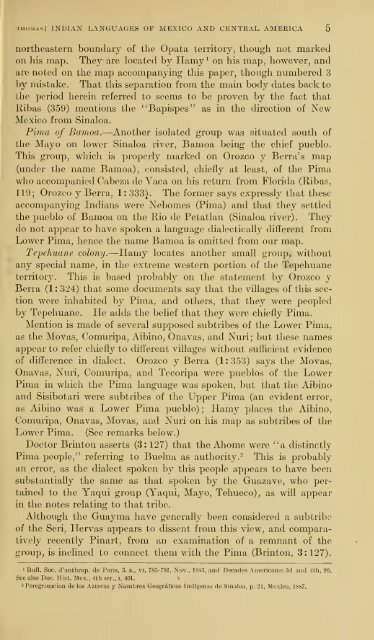Untitled - Smithsonian Institution
Untitled - Smithsonian Institution
Untitled - Smithsonian Institution
You also want an ePaper? Increase the reach of your titles
YUMPU automatically turns print PDFs into web optimized ePapers that Google loves.
IthomasJ INDIAN LANGUAGES OF MEXICO AND CENTKAL AMERICA 5<br />
northeastern boundary of the Opata territory, though not marked<br />
on his map. They are located by Hamy ^ on his map, however, and<br />
are noted on the map accompanying this paper, though numbered 3<br />
by mistake. That this separation from the main body dates back to<br />
tlie period herein referred to seems to be proven by the fact that<br />
Ribas (359) mentions the ''Bapispes" as in the direction of New<br />
Mexico from Sinaloa.<br />
Pima of Bamoa.—Another isolated group was situated south of<br />
the Mayo on lower Sinaloa river, Bamoa being the chief pueblo.<br />
This group, which is properly marked on Orozco y Berra's map<br />
(under the name Bamoa), consisted, chiefly at least, of the Pima<br />
who accompanied Cabeza de Vaca on his return from Florida (Ribas,<br />
119; Orozco y Berra, 1: 333}. The former says expressly that these<br />
accompanying Indians were Nebomes (Pima) and that they settled<br />
the pueblo of Bamoa on the Rio de Petatlan (Sinaloa river) . They<br />
do not appear to have spoken a language dialectically different from<br />
Lower Pima, hence the name Bamoa is omitted from our map.<br />
Te2)ehuane colony.—Hamy locates another small group, without<br />
any special name, in the extreme western portion of the Tepehuane<br />
territory. This is based probably on the statement by Orozco y<br />
Berra (1 : 324) that some documents say that the villages of this sec-<br />
tion were inliabited by Pima, and others, that they were peopled<br />
by Tepehuane. He adds the belief that they were chiefly Pima.<br />
Mention is made of several supposed subtribes of the Lower Pima,<br />
as the Movas, Comuripa, Albino, Onavas, and Nuri; but these names<br />
appear to refer chiefly to different villages without sufficient evidence<br />
of difference in dialect. Orozco y Berra (1 : 353) says the MoVas,<br />
Onavas, Nuri, Comuripa, and Tecoripa were pueblos of the Lower<br />
Pima in which the Pima language was spoken, but that the Aibino<br />
and Sisibotari were subtribes of the Upper Pima (an evident error,<br />
as Aibino was a Lower Pima pueblo) ; Hamy<br />
places the Aibino,<br />
Comuripa, Onavas, Movas, and Nuri on his map as subtribes of the<br />
Lower Pima. (See remarks below.)<br />
Doctor Brinton asserts (3: 127) that the Aliome were "a distinctly<br />
Pima people," referring to Buelna as authority.^ This is probably<br />
an error, as the dialect spoken by this people appears to have been<br />
substantially the same as that spoken by the Guazave, who pertained<br />
to the Yaqui group (Yaqui, Mayo, Tehueco), as will appear<br />
in the notes relating to that tribe.<br />
Although the Guayma have generally been considered a subtribc<br />
of the Seri, Hervas appears to dissent from this view, and compara-<br />
tively recently Pinart, from an examination of a remnant of the<br />
group, is inclined to connect them with the Pima (Brinton, 3:127).<br />
1 Bull. Soc. d'anthrop. de Paris, 3. s., vi, 785-791, Nov., 1883, and Decades Americanae 3d and 4th, 99.<br />
See also Doc. Ilist. Max., 4th ser., I, 401. <<br />
- Peregrinacion de los Aztecas y Nombres Geograficos Indigenas de Sinaloa, p. 21, Mexico, 1887.

















